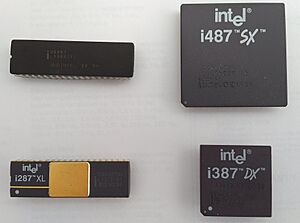Floating-point unit facts for kids
A Floating-Point Unit (FPU) is like a special calculator inside a computer. It's designed to quickly handle numbers that have decimal points, like 3.14 or 0.5. These numbers are called floating-point numbers. FPUs are great at doing math operations such as addition, subtraction, multiplication, division, and finding the square root.
Some FPUs can even do more complex math, like figuring out angles (trigonometry) or how things grow (exponential functions). However, sometimes computers use software to do these complex calculations instead, because it can be more accurate.
Today, most main computer processors (CPUs) have one or more FPUs built right into them. But many smaller, specialized computers, like those found in smart devices, might not have this special math part built in.
When a computer needs to do a floating-point math problem, it can do it in a few ways:
- Using a special software program that acts like an FPU.
- Adding a separate FPU chip to the computer.
- Having the FPU already built into the main processor.
Contents
How FPUs Have Changed Over Time
Computers have been using floating-point math for a long time. In 1954, the IBM 704 computer was one of the first to have floating-point math built in as a standard feature. This was a big improvement over older computers. Other early computers like the PDP-6 and GE-235 also had special units for these calculations.
For many years, the FPU was often a separate part of the computer, called a coprocessor. This could be a single chip, a whole circuit board, or even a large cabinet! If a computer didn't have this special hardware, it would do the floating-point math using software. This made the calculations slower, but it saved the cost of the extra hardware.
Over time, computer designers found ways to make FPUs smaller and faster. They often separated floating-point math from regular whole-number (integer) math. This allowed them to work more efficiently.
Modern FPUs often use clever techniques, like "pipelining," to do many calculations at once. This helps computers run very quickly.
What is a Floating-Point Library?
Some FPUs, especially older ones, only support simple math operations like adding, subtracting, and multiplying. Even the most advanced FPUs can only do a certain number of operations. For example, no FPU can directly handle numbers with endless precision.
When a computer needs to do a floating-point math problem that its FPU hardware doesn't support, the CPU uses a series of simpler operations. If there's no FPU hardware at all, the CPU uses software to pretend it has one. It does this by breaking down the complex floating-point problem into many simpler whole-number calculations that its main math unit (the ALU) can handle.
The software that contains all these instructions for doing floating-point math is often called a floating-point library.
FPUs Built Into the Main Processor
Today, most computers have their FPUs built right into the main processor chip. Sometimes, these built-in FPUs are specialized. For example, they might have separate parts for simple operations (like addition and multiplication) and more complex ones (like division). In some cases, only the simple operations are done by hardware, while the more complex ones are still handled by software.
Modern computer processors often combine FPU features with something called SIMD units. SIMD stands for "Single Instruction, Multiple Data." This allows the FPU to do the same calculation on many pieces of data at the same time, making things even faster. For example, newer Intel and AMD processors use SSE (Streaming SIMD Extensions) instructions to boost their math power.
Adding a Separate FPU Chip
In the 1980s, it was very common for personal computers, like the IBM PC, to have the FPU as a completely separate chip. This chip was usually sold as an optional extra. People would only buy it if they needed to speed up programs that did a lot of math, like spreadsheets or design software.
For example, early IBM PCs had a special slot for an optional 8087 coprocessor. Later computers, like the IBM PC/AT, had slots for the 80287 or 80387 chips. Other companies also made these coprocessor chips for Intel's processors.
Similar add-on chips were available for other computer families, like the Motorola 68000 series, which were used in Apple Macintosh and Commodore Amiga computers. These separate FPU chips helped computers do complex math much faster than if they had to rely on software alone.
Even today, some smaller computer systems, like microcontrollers, can have add-on FPU chips. These chips give them the ability to do floating-point math, even if their main processor doesn't have that feature built in.
See also
 In Spanish: Unidad de coma flotante para niños
In Spanish: Unidad de coma flotante para niños
- Arithmetic logic unit (ALU)
- Address generation unit (AGU)
- Execution unit
- IEEE 754 floating-point standard
- Graphics processing unit
- Multiply–accumulate operation


